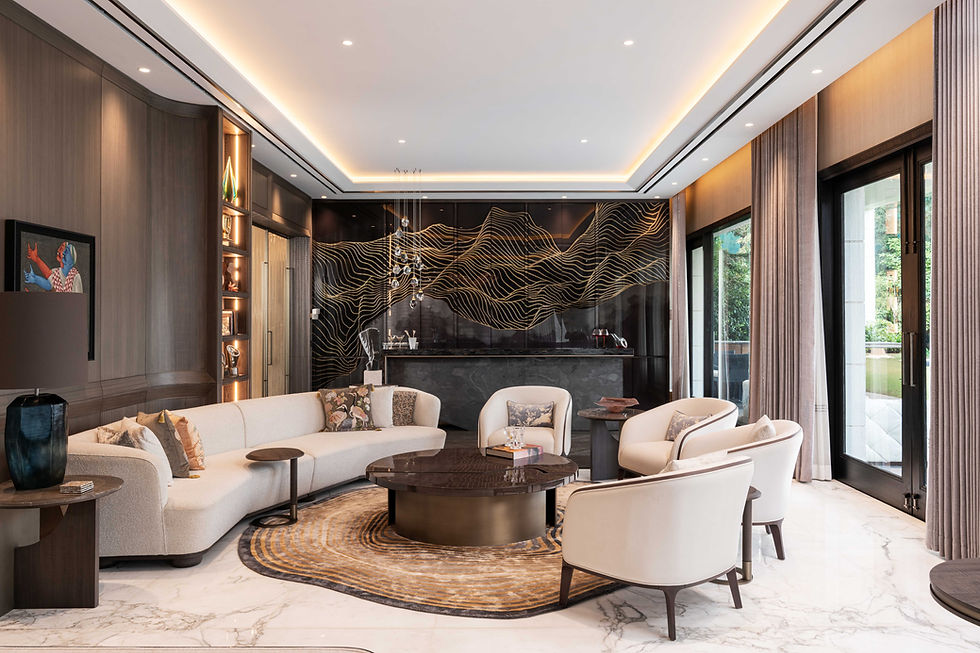Lighting Beyond Illumination: Layered & Integrated Design in Bespoke Interiors
- Marketing FTS
- 14 minutes ago
- 3 min read
Lighting Beyond Illumination: Layered & Integrated Design in Bespoke Interiors
How luxury lighting brings furniture and space to life — and why it matters in a home.

1. The Three Layers of Light — and Why They Matter
In luxury interiors, lighting is much more than “on/off”. To truly elevate a space, we deploy three layers of light:
Ambient lighting — the general background light that sets the overall mood.
Task lighting — targeted illumination for specific activities (reading, dining, display).
Accent lighting — focussed light to highlight surfaces, textures, art or architectural features.
When these layers are designed intentionally, the result is a home that feels considered, adaptable and rich in materiality.
2. Integrated Lighting in Bespoke Furniture: A Design Game-Changer
In our design approach, we believe lighting shouldn’t just sit above the furniture. By seamlessly integrating light sources within custom cabinetry, panelling, millwork and display units, you achieve:
A clean architectural aesthetic (no visible wiring or mismatched fixtures)
Materials and textures shown off at their best (wood grain, metallic finishes, stone veining)
Spaces that adapt: built-in strips, hidden LED channels, timed lighting for mood shifts
3. Bringing It to Life: Residential Project Examples
Below are three projects from your portfolio that exemplify how layered lighting and integrated furniture-lighting merge beautifully in real spaces.
a) DLF Camellias Residence

In this project, ambient lighting is created by a continuous cove around the perimeter of the living/dining zone, providing a soft, even glow that sets the tone for the space. Task lighting is present in the form of a pendant over the dining table and reading lights integrated into the seating zone. Accent lighting plays out in the bespoke bar/display unit: LED strips within shelving pick out the objects and materials (veneer, metal trims), and down-lights hidden in the cabinetry define edges and textures. The furniture and lighting are worked in tandem so that the cabinetry becomes part of the luminaire logic—every element is intentional.

b) DLF Camellias Residence

In this second Camellias-based project, ambient light is softly provided via concealed valance lighting behind the ceiling perimeter. Task lighting surfaces in built-in reading lights beside seating and within head-board zones. For accent, integrated LED strips inside wardrobes softly illuminate the contents and finishes, while a back-lit wall panel quietly glows around the bed zone to bring out the wood texture. The underlying principle remains: the furniture becomes the framework for lighting rather than lighting simply being an add-on.

c) Prakriti Marg Residence

Here, the architectural intent starts with warm wooden panelling linking two rooms into one consolidated space. Ambient lighting is achieved by indirect washes behind the panelling and along ceiling coves, enhancing the sense of warmth and continuity. Task lighting is integrated into the full-height bar unit and custom shelving zones — allowing both display and utility. For accent, concealed LED lines highlight metal trims, lacquered glass surfaces and the detailing of the bar-unit. The furniture and interior surfaces form a cohesive lighting canvas: light is hidden, yet its effect defines the design.

4. Practical Tips for Designing Your Own Layered & Integrated Lighting Scheme
To bring this philosophy into your own home (or for clients), here are some actionable guidelines:
· Begin with the architecture and furniture: ask how built-ins, panelling, shelving, wardrobes can include lighting channels.
· Define zones: Where do you need ambient vs task vs accent? Dining, kitchen island, wardrobe, artwork display.
· Choose the right colour temperature: For luxury interiors we often favour warm (2700–3000K) for wood/textile-heavy rooms; cooler temps only if very contemporary stone/metal surfaces dominate.
· Consider dimming and layering: Each layer should have its own control. You might want full ambient for entertaining, reduced ambient + accent for relaxed evenings.
· Use hidden light sources where possible: Cove lighting, behind panels, within cabinetry. This keeps fixtures discreet and the furniture/fabric/surface the hero.
· Match light intensity to scale: For built-in furniture display you may only need low lux but high directional control; for task (kitchen or reading) ensure brighter, glare-controlled light.
· Don’t forget maintenance: With integrated lighting ensure access for bulb/LED strip replacement and check heat-management in enclosed cabinetry.

5. Why This Matters in Luxury Interiors
When done with keeping the client in mind, reaching for perfection, lighting and furniture integrate so seamlessly that there is synergy in your home than just a collection of components. In our work, this synergy is fundamental: the furniture is designed with lighting in mind, and the lighting scheme respects the materials, finishes and mood of the space.It’s about creating a home that works in every light—daylight, evening, mood. It’s about making every surface, every piece of furniture, every panel feel intentional. That is what distinguishes a luxury interior from a standard one.




Comments